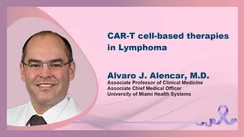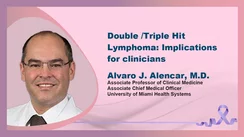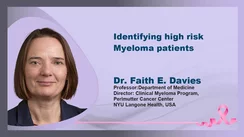Lenalidomide Maintenance Therapy Improved Progression-free Survival in Patients with Newly Diagnosed Multiple Myeloma

Lenalidomide Maintenance Therapy Improved Progression-free Survival in Patients with Newly Diagnosed Multiple Myeloma
Multiple myeloma is a relatively uncommon cancer; approximately 0.8% of men and women can develop this disease at some point in their time as per the data derived from 2017 to 2019. The risk of developing this cancer is higher in men than in women and stands as the 14th leading cause of death due to cancer.The 5-year survival rate of this disease is approximately 57.9%.1
Lenalidomide is an immunomodulatory drug that helps in the maintenance therapy of patients with newly diagnosed multiple myeloma following autologous stem-cell transplantation. However, the beneficial effect of lenalidomide therapy has shown varying results across various individual studies. Further, these studies were neither randomized nor sufficiently powered to derive any robust conclusions for using lenalidomide as maintenance therapy in newly diagnosed multiple myeloma.
Myeloma XI is a multicentric, open-label, randomized, Phase 3 Trial2 conducted at 110 National Healthcare Services hospitals in England, Wales, and Scotland to demonstrate the efficacy and safety of lenalidomide maintenance therapy in patients with newly diagnosed multiple myeloma. The study also evaluated the effect of lenalidomide therapy in patients with cytogenetic risk and transplantation status subgroup. Adult patients (aged 18 years and above) diagnosed with symptomatic or non-secretory multiple myeloma (based on bone marrow clonal plasma cells, myeloma-related organ or tissue impairment, or paraprotein [M-protein] in serum or urine) were eligible for the study.
The study comprised three randomization stages. The first was the induction treatment phase where all transplantation eligible patients received at least 4 cycles of cyclophosphamide, thalidomide, and dexamethasone (CTD) or cyclophosphamide, lenalidomide, and dexamethasone (CRD) or at least 6 cycles of carfilzomib, cyclophosphamide, lenalidomide, and dexamethasone (KCRD). Patients treated with KCRD were ineligible for the next treatment phases. Transplantation-ineligible patients were randomized to CTD or CRD. In the next phase (intensification treatment phase), patients who showed minimal response or partial response were further randomized to receive cyclophosphamide, bortezomib, and dexamethasone (CVD) or no CVD. Patients who completed the induction and intensification treatments were further randomized to lenalidomide 10 mg/day (orally on days 1–21 of each 28-day cycle) or were observed without lenalidomide therapy (observation group) (maintenance treatment phase).
A total of 4420 patients were enrolled in the induction treatment phase; of these, 1971 patients proceeded to maintenance therapy (lenalidomide: 1137 patients; observation: 834 patients). The median follow-up for this study was 31 months. Patients treated with lenalidomide maintenance therapy demonstrated better progression-free survival than those in the observational group (see Table 1).
Survival | Lenalidomide Group | Observation Group |
Median progression-free survival | 39 months (95% CI 36–42) | 20 months (18–22) (HR 0.46) [95% CI 0.41–0.53] |
Median overall survival | (95% CI 66-not reached) | (95% CI 61-not reached) |
3-year overall survival | 78.6% (95% Cl 75.6–81.6) | 75.8% (72.4–79.2) (HR 0·87) [95% CI 0·73–1·05] |
5-year overall survival | 61.3% (95% CI 56.6–66.1) | 56.6% (95% CI 51.5–61.7) |
Median progression-free survival | 64 months (95% CI 57-not reached) | 45 months (41–50) (HR 0.65) [95% CI 0.56–0.77] |
Progression-free survival was significantly improved in patients who were eligible for transplantation and treated with lenalidomide versus patients in the observation group (57 months versus 30 months; p<0.0001) as well as those who were ineligible for transplantation and treated with lenalidomide (26 months versus 11 months; p<0.0001). Progression-free survival was also significantly improved in all three cytogenetic risk groups (standard risk, high risk, and ultra-high risk) following lenalidomide maintenance therapy. Although the overall 3-year survival for both groups remained similar (78.6% versus 75.8%), patients with transplantation eligibility (87.5% versus 80.2%) and with cytogenetic risk (86.4% versus 81.3%) demonstrated better overall survival outcomes when treated with lenalidomide versus those who were in the observation group. Sub-group analysis of the cytogenetic risk group demonstrated that lenalidomide maintenance therapy improved the outcomes in patients with high-risk (74.9% versus 63.7%) and ultra-high risk (62.9% versus 43.5%) than those who were not treated with lenalidomide (observation group).
The safety findings of this study were in line with the known safety profile of lenalidomide. An equal number of patients in both lenalidomide (234 patients, 21%) and observation (226 patients, 27%) died during the study andno deaths in the lenalidomide group were considered treatment related. There were no lenalidomide-related deaths; Grade 3 or 4 adverse events following lenalidomide maintenance therapy were mainly hematological and included neutropenia (33%), thrombocytopenia (7%), and anemia (4%). The most severe adverse effect in both groups was an infection.
Although the Myeloma XI study had a very good number of patients enrolled, it should be noted that the subgroup analyses were not powered due to the unavailability of cytogenetic data for analysis for most patients and hence reduced sample size. Further studies are warranted to ascertain the use of lenalidomide in these specific populations of the study, which also did not collect any quality-of-life data during the prospective study period. Nevertheless, the results of this study are consistent with the earlier lenalidomide studies and demonstrated that lenalidomide maintenance therapy improved progression-free survival in patients who were newly diagnosed with multiple myeloma as well as in both transplantation-eligible and transplantation-ineligible patients. Although the overall survival was similar in both treatment groups, continuous treatment with lenalidomide improved the overall survival in the transplantation-eligible patients.
References:
1. https://seer.cancer.gov/statfacts/html/mulmy.html
Jackson GH et al. Lenalidomide maintenance versus observation for patients with newly diagnosed multiple myeloma (Myeloma XI): a multicenter, open-label, randomised, phase 3 trial. Lancet Oncol. 2019;20:57-7
Disclaimer: The Views/Opinions expressed and/or opinions provided in Videos and other content on MedEnrich Website are those of respective speakers. They do not purport to reflect the opinion or views of Dr.Reddy’s Laboratories Limited or its affiliates (collectively Dr.Reddy’s)in any manner whatsoever and accordingly ,Dr.Reddys does not recommend , endorse or make any representation about the veracity and appropriateness of the views ,opinions/ information on MedEnrich website. Content on MedEnrich website may discuss uses and dosage for therapeutic product that may not have been approved in by the relevant regulatory agencies in your country. Dr.Reddy’s does not support , endorse or encourage any off-label use. Please refer to approved label before prescribing.




